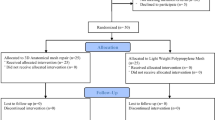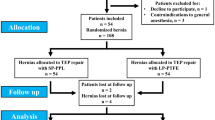Abstract
Most patients who come to a general hospital in a developing country are poor. The most important prohibiting factor for use of polypropylene mesh in hernia repair is its exorbitant cost. Hence, research workers have been on the lookout for an equally effective but economically affordable mesh. Worldwide, surgical repair of inguinal hernia is the most common general surgery procedure performed at the present. Lifetime risk of groin hernia is 15% in males and 5% in females. Most of the patients who visit a general hospital are from either lower middle class or poor socioeconomic strata. The most important prohibiting factor for use of polypropylene mesh in hernia repair for the common man is its exorbitant cost. The aim of this study is to document the feasibility, safety and cost-effectiveness of the use of polyethylene mesh. A single blind, prospective, randomized controlled study, comparing 35 patients of two groups was conducted in a tertiary teaching hospital over a period of 5 years. The patients in both groups underwent inguinal hernioplasty, and were administered similar antibiotics and analgesics. The postoperative course with regard to pain, seroma formation, infection, hospital stay, recurrence and scar quality was evaluated and compared. Statistical analysis was performed with Chi square test. The properties of both meshes were the same with respect to ease of handling, pain score, seroma formation, infection rate, resumption of daily activities, scar quality and mesh rejection. Recurrence rate was zero for both groups. Polyethylene mesh was 2,808 times cheaper than the commercially available polypropylene mesh. This study proved the safety, simplicity, efficacy and cost-effectiveness of polyethylene mesh for inguinal hernia meshplasty, insuring economical, accessible health care for the financially weak section of the population.
Similar content being viewed by others
References
Javid PJ, Brook DC (2007) In: Maingot’s Abdominal Operations, chap. 5, 11th edn. Mc Graw Hill, USA, pp 103–120
Debord JR, Whitty LA (2007) Biomaterials in hernia repair. In: Mastery of Surgery, chap. 180, 5th edn. Lippincott Williams & Wilkins, Philadelphia, pp 1965–1969
Usher FC (1959) A new plastic prosthesis for repairing tissue defects of chest and abdominal wall. Am J Surg 97(5):629–633
Usher FC (1960) A new technique for repair of inguinal hernia. Arch Surg 81:847–854
Tongoankar RR et al (2003) Preliminary trial of indigenous mesh for hernia repair. Indian J Surg 65(1):90–96
Read RC (1984) The development of inguinal herniorrhaphy. Surg Clin North Am 64:185–196
Malangohi MA, Rosen MJ (2008) In: Sabiston text book of surgery, the biologic basis of modern surgical practice, chap 44, vol 2. Saunders Elsevier, Philadelphia, pp 1155–1170
Amid PK, Pichtensteil IL (1995) The goals of modern hernia surgery. How to achieve them open for laparoscopic repair? In: Problems in general surgery, vol 12. Lippincott Raven, Philadelphia, pp 165–171
Nyhus LM, Condon RE (1995) Hernia 4th edn. Lippincott, Philadelphia
Freudenberg S, Sano D, Ouangre E, Weiss C, Wilhelm TJ (2006) Commercial mesh versus Nylon mosquito net for hernia repair. A randomized double-blind study in Burkina Faso. World J Surg 30:1784–1789
Clarke MG, Oppong C, Simmermacher R, Park K, Kurzer M, Vanotto L, Kingsnorth AN (2009) The use of sterilized polyester mosquito net mesh for inguinal hernia repair in Ghana. Hernia 13(2):155–159
Shillcutt SD, Clarke MG, Kingsnorth AN (2010) Cost effectiveness of groin hernia surgery in the western region of Ghana. Arch Surg 145(10):954–961
Klosterhalfen B, Junge K, Klinge U (2005) The light weight and large porous mesh concept for hernia repair. Expert Rev Med Devices 2(1):103–117
Wilhelm TJ, Freudenberg S, Jonas E, Grobolz R, Post S, Kymanywa P (2007) Sterilised mosquito net versus commercial mesh for hernia repair. Eur Surg Res 39:312–317
Conflict of interest
There was no conflict of interest for this study.
Author information
Authors and Affiliations
Corresponding author
Rights and permissions
About this article
Cite this article
Gundre, N.P., Iyer, S.P. & Subramaniyan, P. Prospective randomized controlled study using polyethylene mesh for inguinal hernia meshplasty as a safe and cost-effective alternative to polypropylene mesh. Updates Surg 64, 37–42 (2012). https://doi.org/10.1007/s13304-011-0103-6
Received:
Accepted:
Published:
Issue Date:
DOI: https://doi.org/10.1007/s13304-011-0103-6




